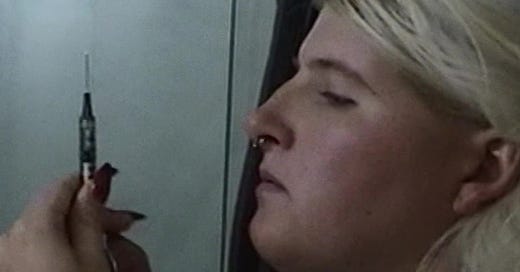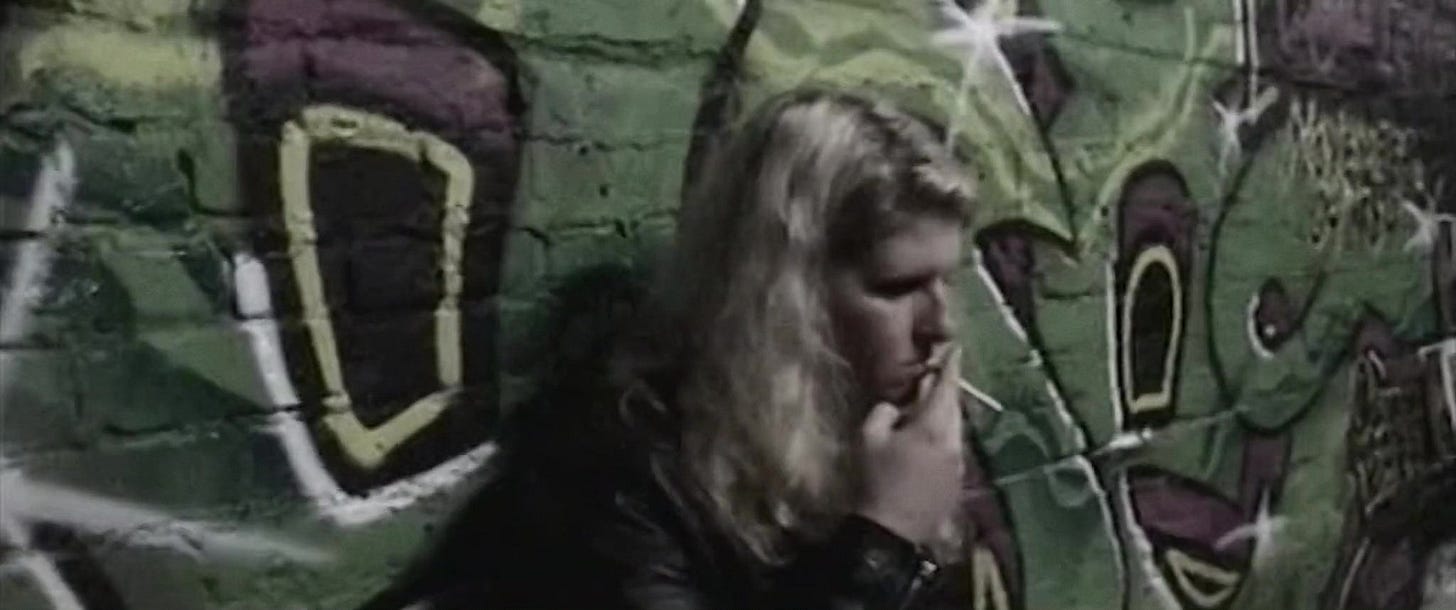Louise Weard's Castration Movie Anthology: Traps
I didn’t know how much I needed a transsexual ultra-realist cinema until I did.
Ultra-realism in transsexual and transgender storytelling comes at the price of being known, and the price of being known for us is that our humanity is being used as a tool to dehumanize us to the point of extinction.
Being known is our Rubicon. We will cross it and cross it again.
Castration Movie is a 15-hour epic, broken into chapters. It’s shot on Hi-8.1 The version that I saw last night in Long Beach was about 4.5 hours long, including a short intermission. Part I, which is circulating in an abridged form, has a story, and it comes to a place of rest, but not a terminus.
It’s comfortably “anti-lighting.” The language of camera movement is reassuringly absent. In a recorded post-show interview, Weard described it as “anti-movie,” I think. It tells you it’s a movie, because, well, it isn’t. She never intended it to be seen in a theatrical release, or by a wide audience. Too late for that intention.
Conversations play out in their full-length, in real-time. People fuck and it’s exciting to watch them, until it’s just happening and the lines start repeating themselves and you see your own rhythms mirrored. Bodies move in domestic spaces, slowly. Arguments build until you’re inside of them. The division between cells of friend-groups puts you slightly on edge.
You’re in the room.2 Maybe you’re in a room for a long time and you don’t want to be in that room. You’ve been in that room, before, and you never want to go back to that room, again. Maybe you’ve never been in a room like that before.
When the characters in Castration Movie tell you what they are, believe them.
An incomplete epic where shots play out in jumpy, episode-long slices rejects summary, which is a rejection of the oversimplification of transsexual and transgender life, even if the film is a aggregate of tropes.3 I spent much of the first chapter “Incel Superman,” laughing riotously with spikes of ultra-cringe, the small crowd raw and intimate as we learned one another’s voices an cackles. Moving on to the second part, concerned with Michaela “Traps” Sinclair, played by Weard, the laughter slowly fades until everyone is submerged into a crumbling world of real and unreal insecurity and lashing outs.
There’s stuff I’d like to talk about, if we saw it together. There’s so much to talk about.4 A summary would be absurdly long. Can maximilism repulse criticism?
The moment in Castration Movie that hit me in the deepest, realest place takes part in this second chapter, when Traps goes to her friend Persephone’s5 place to pick up a vial of estradiol.6
Persephone doesn’t have any, because she orders her supply from the Ukraine, and the war has begun. Traps doesn’t seem to know about the war, doesn’t quite process the stakes. I imagine this scene was shot a while back.
For maybe ten minutes, sitting there, my body intertwined with my companion for the evening, hands moving without real intention, I’m not there, I’m in a future time and place where I won’t be able to get the next vial of estradiol that keeps me alive. Because it does. It really does feel like that.
Yesterday, I lost my Medi-Cal, which carried me from the first moments of the medicalization of my transsexuality until June 30, 2025, when I saw Castration Movie for the first time. Today is the first day of my healthcare under an ACA plan that’s free because I’m too poor to have to pay for insurance in California. I don’t trust that when my vial runs out, there will be another one.
For a moment, I contemplate the difference between a future of forced detransition and a future where you just can’t get the meds you need, call it post-apocalyptic detransition. In one of those futures, I see myself in “Alligator Alcatraz” the concentration camp they’re building in Florida, caged and shaven-headed, the FFS scar that runs from ear-to-ear raw, ugly, and sunburnt. For a moment, security leaves me and the impotent rage that motivates some of Traps’ worst instincts wriggles in the place it lives inside all of us.
Castration Movie hit me in a bunch of places, but the place I knew it would hit first was in the formatting. In the late 1990s, I convinced my adoptive father to help me buy a Canon L2, a very expensive Hi-8 camera, so I could start making slice of life movies with my friend David Holmes. Shortly after, Dave had a psychotic break, became a Calvinist (briefly), decided to blame all of his friends for his earlier choices, and, then, kind of came back into the world for a minute. I remember being at Burning Man with him in 1998, Canon L2 in hand, watching him wear his mother’s housecoat, the two of us not speaking for days at a time. Frivolous filmmaking did happen, but nothing serious ever manifested. About a decade-and-a-half later, Dave, having spent a long time in a cult, put a bullet in his head.
Basically, a cute, artistic guy became an incel sometime in the late-90s, which was the real trigger pull. The worst part was watching that bullet travel in slow motion, a sixteen year passage from barrel to skull.
I won’t say it wasn’t weird that the theatre in Long Beach is on the same block where Dave and I played shows in a noise band back in the 20th century, with me in a vinyl maid’s dress, fishnets, and a shitty blond wig, making the sound of my transsexual people, a rack of synthesizers puking up the loudest noise you’ve ever heard. If I was a feral transsexual adrift and barely surviving, Dave was underwater, an incel without a manifesto or 4Chan feed him oxygen.
I ditched the Canon last year when my home by the investment company that owned it. People really focus on cutting off your cock or your tits when you’re getting a sex change, but that’s so much easier to cut away than everything that carried you to that moment that’s no longer necessary.
It’s impossible to watch Castration Movie and not think about Larry Clark’s Kids, or Linklater’s Slacker, or Cleo from 5 to 7, or the last video essay you watched by a Queer YouTuber with not enough followers to make ends meet who is considering OnlyFans.
I used to teach film and narrative theory and narrative concepting at a major art school in Los Angeles, and I loved teaching first features, and one of the hallmarks of a first (or second) feature is that the filmmaker throws everything into the pot. And this isn’t bad - it leads to brilliances like Gregg Araki’s Totally F***ed Up and Allison Anders’ Mi Vida Loca, both of which I loved to teach.
Totally F***ed Up is Castration Movie’s purest ancestor, lo-fi, a 15-part anthology of bits and cultural tropes, and, ultimately, the one film I could show Queer students at Otis College where they could see a Queer Otis student from the AIDS Era, their own ancestor, on screen. The turkey baster lesbian insemination scene walked so that Castration Movie could run, so to speak.
Mi Vida Loca’s first act is a whole goddamn movie unto itself. It’s a trilogy compacted into a single film, a storyteller’s urges confined to an era of independent film that didn’t have four hour-long video essays on YouTube as a possibility and narrative reference. It would be a season of prestige television if it were made today, or an anthology film shot on phones by people who never considered film school. But Anders knew what she was up against - most women only get one feature, one shot, ever.
Now extend that one-shot logic to transgender women, who have no shot, no chance, and are the object of desire and disgust in equal measure in the time of our own slowly creeping genocide….
At multiple points in the viewing, I felt something of the same sense of ask on the part of the author as I felt as an audience member and participant in Taylor Mac’s A 24-Decade History of Popular Music, which I saw in multiple six-hour blocks. That’s my double feature, takeaway. a 24-hour performance and a 15-hour film, back to back, or, maybe, woven together.
Never has the joy of self-naming and creation myths of ourselves been more rolled around in than in this film.
Like Weard and many others, I’ve shot up on film, in the video for Dorian Wood and Thor Harris’ The Angel. It just feels important to create a record of how we lived in this time, as transsexual people. If you want to see a transfemme in a delicate part of her transition shooting up estradiol valerate and muffing and sounding herself, face unseen, still imagining that she could do things like keep her job or not live in the beautiful twilight of an eroticized and increasingly desperate underground, that one’s for you.
The images and recorded moments of our lives are ready-to-go memorials if we don’t make it, I guess. Social media is our mass grave, maybe.





